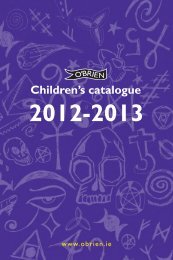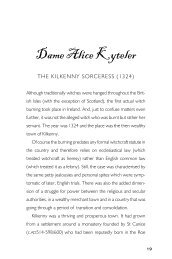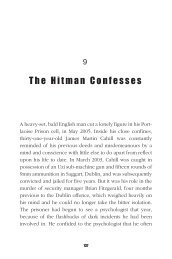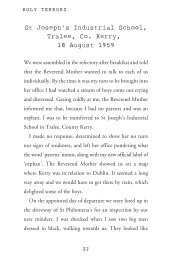Teaching Guide - The O'Brien Press
Teaching Guide - The O'Brien Press
Teaching Guide - The O'Brien Press
Create successful ePaper yourself
Turn your PDF publications into a flip-book with our unique Google optimized e-Paper software.
RATIONALE AND THEMES<br />
Wildflower Girl is the second book in Marita<br />
Conlon-McKenna’s famine trilogy. It is a<br />
sequel to Under the Hawthorn Tree, which<br />
tells the story of the O’Driscoll children’s<br />
journey through nineteenth-century<br />
famine-torn Ireland to find their great-aunts.<br />
Wildflower Girl traces the fortunes of Peggy<br />
O’Driscoll, now aged thirteen, as she leaves<br />
Ireland and makes her way to America.<br />
Wildflower Girl won the CBI/Bisto Book of the<br />
Year, 1992, in the Historical Novel Category.<br />
It is suitable for use with senior classes in<br />
primary schools and with junior classes in<br />
second-level schools. It facilitates exploration<br />
of the following themes:<br />
Emigration from Ireland to America<br />
Independence and responsibility<br />
Journey<br />
Conflict<br />
Exile and loneliness<br />
Exploitation and racial discrimination<br />
Courage and resilience<br />
Economic migrants<br />
SUMMARY<br />
Peggy O’Driscoll, aged thirteen, sees no<br />
future for herself in the impoverished<br />
post-famine Ireland of the nineteenth<br />
century. With her passage paid by the<br />
landlord, she leaves her sister and<br />
brother and her beloved great-aunt and<br />
sets out on a huge adventure to seek her<br />
fortune in America. After a distressing sea<br />
voyage from Queenstown to Boston she<br />
secures employment as a skivvy in a<br />
men’s boarding house run by the<br />
disreputable Mrs Cavendish. In<br />
desperation Peggy runs away and with<br />
the help of fellow expatriates secures<br />
other more suitable employment. Life is<br />
WILDFLOWER GIRL ISBN 978-0-86278-283-2 pb<br />
MARITA CONLON-McKENNA<br />
<strong>Teaching</strong> <strong>Guide</strong><br />
By Irene Barber<br />
tough with poor wages, long hours, hard<br />
work and little respect. But Peggy is a<br />
survivor and her hard work, courage,<br />
loyalty and resilience impress those<br />
around her as she grows in confidence<br />
and wisdom. It is an optimistic and<br />
happy Peggy we leave on the final pages<br />
of the book.<br />
APPROACH<br />
For the purposes of this exploration, the<br />
novel is divided into five units. Each unit is<br />
approximately thirty pages long. Possible<br />
discussion points and activities are listed at<br />
the end of each unit. Two useful addresses<br />
on emigration from Ireland are:<br />
1. Cobh Heritage Centre, Cobh, Co.<br />
Cork, Tel: +353 (21) 813591 (www.cobh<br />
heritage.com)<br />
2. Ulster American Folk Park,<br />
Castletown, Omagh, County Tyrone BT78<br />
5QY. Tel: 048 82 240918 (www.<br />
folkpark.com)<br />
SUMMARY<br />
UNIT 1<br />
FAREWELL<br />
An offer of a passage to America arrives<br />
to the O’Driscoll house – a godsend in<br />
times of economic ruin. But how can<br />
the three young people go and leave<br />
their aging great-aunt Nano?<br />
Circumstances change when Eily, the<br />
eldest, accepts a proposal of marriage<br />
and Michael gets a suitable job offer.<br />
That leaves Peggy, the youngest, who<br />
despite opposition, is determined to go<br />
to America alone. Having said her<br />
goodbyes, she heads for Queenstown<br />
1<br />
(now Cobh) in the company of a<br />
neighbour’s family, the Molloys. Here<br />
she is issued with a ticket to travel<br />
steerage on the Fortunata to Boston.<br />
Read pp.9–43.<br />
DISCUSSION POINTS<br />
Originally Eily decided that no one of<br />
the family was going to America. What<br />
changed her mind?<br />
From what you have read about Peggy<br />
so far do you think she will do well in<br />
America? What kind of a person is she?<br />
What kind of person is likely to succeed<br />
in a new and alien environment?<br />
In 1992, an American academic, Dr<br />
Marjorie Hancock, initiated a study of<br />
Irish and American children’s<br />
responses to Marita Conlon-<br />
McKenna’s Under the Hawthorn Tree<br />
and Wildflower Girl. <strong>The</strong> Irish pupils’<br />
response to Peggy leaving Ireland was<br />
very intense – many expressed deep<br />
commitment to their homeland and<br />
feelings of guilt and real sadness at the<br />
thought of leaving. However most<br />
American pupils expressed no doubt<br />
about leaving starvation and death<br />
behind (Children’s Books in Ireland,<br />
1995)! How do you explain the<br />
differing responses from the different<br />
nationalities?<br />
What might be the significance of the<br />
gifts Peggy received from her family:<br />
the Bible, the horsehair bracelet, the<br />
purse of money, the shawl?<br />
ACTIVITIES<br />
<br />
1. ANGER<br />
What provoked Eily’s anger to the extent<br />
that she slapped Peggy across the face?
What was Peggy’s response? What<br />
happened next? Write about an occasion<br />
when you were so angry that you hit out (or<br />
really felt like hitting out) at someone. How<br />
did they respond? Was the situation<br />
resolved? What would have happened if<br />
you had chosen to hide your anger?<br />
Looking back, was it a good or bad thing to<br />
show your anger?<br />
<br />
2. REFUGE<br />
Peggy had a favourite place to where she<br />
ran when she was troubled – the bridge.<br />
Write about where you go when you want<br />
peace and quiet to work things out.<br />
<br />
3. BRIDGES<br />
Marita Conlon-McKenna uses the bridge<br />
as a device to link:<br />
(1) the old with the new<br />
(2) the town with the country<br />
Read pp.11–12 and try to explain how she<br />
uses this device.<br />
<br />
4. KEEPING UP APPEARANCES!<br />
Why was it so important to Nano that she<br />
should be seen at her best when Billy Kelly,<br />
the landlord, called? What did she do in<br />
order to impress him? Write an account of<br />
the meeting from the landlord’s point of<br />
view (see pp.17–20). Try to convey the fact<br />
that he is sympathetic and sensitive to<br />
Nano’s problem but that his own<br />
economic circumstances are dictating his<br />
actions.<br />
5. WILDFLOWER GIRL<br />
With the help of an appropriate source,<br />
sketch a cowslip, buttercup, bluebell,<br />
ragged robin and cow parsley. Redesign<br />
the book cover using some or all of your<br />
flower sketches.<br />
6. COBH HERITAGE CENTRE<br />
Peggy left Ireland from Queenstown (now<br />
Cobh). Look up the website of Cobh<br />
Heritage Centre (www.cobhheritage.com)<br />
and answer these questions:<br />
(a) Two and half million people left<br />
Ireland from Cobh between 1848–1950.<br />
What conditions caused so many to leave?<br />
(b) What is the e-wall at Cobh Heritage<br />
Centre?<br />
(c) Find out five facts about Annie Moore.<br />
UNIT 2<br />
THE LONG VOYAGE<br />
SUMMARY<br />
Peggy sets sail for America on board the<br />
Fortunata in the company of the Molloy<br />
family. After ‘five stinking rotten smelly<br />
disgusting weeks’ they arrived at<br />
Boston. Officials from the Boston Port<br />
Authority dispatch the Molloy family to<br />
a hospital on Deer Island. Peggy is<br />
deemed healthy enough to land in<br />
America. Peggy disembarks, hoping<br />
that she will never have to endure such<br />
a journey ever again.<br />
Read pp.44–71.<br />
DISCUSSION POINTS<br />
Describe the conditions that made the<br />
journey so miserable for passengers.<br />
Why did they not complain?<br />
Why were the women so bitter about<br />
the major clean-up of steerage which<br />
was organised before entering Boston<br />
harbour?<br />
Should Peggy have said she was with<br />
the Molloy family and accompanied<br />
them to Deer Island to help out with<br />
the children?<br />
‘<strong>The</strong> wooden deck was polished and<br />
shone but the under-side of the ship<br />
was covered with gray barnacles and<br />
slimy green seaweed!’ (p.45). Here we<br />
get a hint that things may not be as they<br />
seem on first impressions. How is this<br />
theme of false impressions, being<br />
created by the captain, developed as<br />
this unit progresses?<br />
ACTIVITIES<br />
1. LETTER WRITING<br />
Have Peggy write to Eily, her older sister,<br />
describing honestly the terrible conditions<br />
on board the Fortunata. Describe in detail<br />
what might have caused the most<br />
discomfort to Peggy: the seasickness, the<br />
storm, the lack of privacy, the attitude of<br />
the captain, the suffering of the Molloy<br />
family, the apprehension about what<br />
would happen when they reached<br />
America, and so on.<br />
2. QUESTIONS AND ANSWERS<br />
<strong>The</strong> captain ordered a major clean up of<br />
steerage and then ‘disappeared up on deck<br />
before a hundred questions could be asked’.<br />
2<br />
<br />
<br />
List at least five questions which might<br />
have been asked. (A volunteer could role<br />
play the captain in the ‘hot seat’ attempting<br />
to answer a selection of these questions).<br />
3. PREDICTION<br />
Pretend Peggy was deemed too ill to travel<br />
on to Boston and was sent to Deer Island.<br />
Describe her journey to the island and her<br />
first impressions of the hospital<br />
4. WORD STUDY<br />
Put these words in alphabetical order and<br />
write their dictionary meanings:<br />
provisions, steerage, ship-shape, slops,<br />
mast, barnacles, pulleys, gangplank.<br />
Which word is not a noun?<br />
Try to write a coherent paragraph that<br />
includes all the words!<br />
SUMMARY<br />
UNIT 3<br />
SKIVVY<br />
Peggy meets Mr Molloy and gives him<br />
news of his family. <strong>The</strong>n she and her<br />
friend Sarah make contact with Mrs<br />
Halligan, landlady and proprietor of the<br />
Shamrock Agency for the Employment<br />
of Young Ladies. Mrs Halligan gives the<br />
girls food, rest and a chance to clean up<br />
before finding employment for them.<br />
Peggy gets a job with Mags Cavendish<br />
who runs a boarding house for men.<br />
Conditions are squalid and the drunken<br />
bullying behaviour of the landlady is too<br />
much for Peggy. She runs away back to<br />
Margaret Halligan who surprisingly<br />
shows her great kindness and<br />
understanding. Peggy’s next<br />
employment is with the Rowan family,<br />
in a fine house outside the city. Things<br />
are looking up for Peggy.<br />
Read pp.72–103.<br />
<br />
<br />
DISCUSSION POINTS<br />
Do you think Mags Halligan was a<br />
good person? How did she make a<br />
living?<br />
Why was Mona Cavendish so angry<br />
with Peggy? Was Peggy right to leave in<br />
such a hurry?<br />
When Mrs O’Connor, the cook of<br />
Rushton, said ‘Got to look after my<br />
own!’ what did she mean?
ACTIVITIES<br />
1. SKIVVY<br />
<br />
Write a sense poem entitled ‘Skivvy’ about<br />
Peggy’s stay with Mrs Cavendish. Begin<br />
each line like this:<br />
I see .........<br />
I hear.........<br />
I smell.........<br />
I feel......<br />
I taste........<br />
I think.......<br />
Now re-write, omitting I see, I hear etc.<br />
from the beginning of each line. Improve<br />
on your choice of words. Consider rhyme,<br />
alliteration, line length, shape on the page<br />
and produce final draft.<br />
2. A PREVIOUS LIFE<br />
‘If you don’t cry, it will break your heart’<br />
(p.93). What did Mags Halligan mean by<br />
this? Do you agree? She said: ‘We all miss<br />
our homes and the ones we love’. Where,<br />
do you think, was her home? Who were<br />
the ones she loved? Why is she not with<br />
them?<br />
Invent a life for her before Peggy met her.<br />
Discuss it with a friend. Write Mags<br />
Halligan’s life story so far.<br />
<br />
<br />
3. PREDICTION<br />
So far we have met the following people in<br />
the Rowan household:<br />
Mrs Madden, the housekeeper<br />
Mrs Elizabeth Rowan, the mistress of<br />
the house<br />
Mrs O’Connor, the cook<br />
Kitty, the maid<br />
Predict what will happen next. Will Peggy<br />
be happy? Who will be her friends? Who<br />
will make life difficult for her? How? Will<br />
she stay? Write a summary of your ideas.<br />
<br />
4. WANTED: CAPABLE GIRL<br />
Write the advertisement for a kitchen maid<br />
that Mrs Elizabeth Rowan might have<br />
placed in the Greenbay Times.<br />
Write the letter of application that Peggy<br />
might have written in response to the<br />
advertisement.<br />
UNIT 4<br />
WILDFLOWER GIRL<br />
SUMMARY<br />
Peggy settles in to domestic service with<br />
the Rowan family. Life is hard but she<br />
makes friends with Kitty, another maid,<br />
and undertakes to teach her to read and<br />
write. With her first pay packet she visits<br />
Boston and makes contact with her<br />
friend Sarah. She gets on the wrong side<br />
of Roxanne, the spoiled teenage<br />
daughter of the house. Roxanne falsely<br />
accuses Peggy of stealing a ring. While<br />
Peggy is under suspicion, the rest of the<br />
staff treat her with coolness.<br />
Read pp.104–138.<br />
DISCUSSION POINTS<br />
<strong>The</strong> Trade Union Movement was well<br />
established in America by the end of<br />
the nineteenth century. Workers<br />
banded together to fight for<br />
improvements in their working<br />
conditions and in their pay. <strong>The</strong>y used<br />
strikes to force employers to agree to<br />
their demands. What aspects of<br />
Peggy’s conditions of employment at<br />
the Rowans have been improved on by<br />
trade union negotiations over the<br />
years? Visit the American Irish<br />
Historical Society website<br />
(www.aihs.org) to find out how Irish<br />
emigrants contributed to the Labour<br />
movement in America.<br />
When Roxanne said ‘Those Irish!’ what<br />
insult did she intend? What is so unfair<br />
about a comment such as ‘Those<br />
refugees’ or ‘Those Travellers!’ What<br />
stereotypes might the speakers be<br />
implying?<br />
<strong>The</strong> image of Peggy as the Wildflower<br />
Girl is first introduced on pp.34–35 in<br />
the first unit. It is repeated here in this<br />
unit in Chapter 6. What does this<br />
image tell us about Peggy? What does<br />
its repetition here add to the novel?<br />
<strong>The</strong> Irish who emigrated to America in<br />
such large numbers after the Famine<br />
started at the bottom economically and<br />
worked their way up. Typically they<br />
began as labourers and domestics and<br />
the men worked their way up to skilled<br />
and semi-skilled craftsmen, policemen<br />
and firemen. <strong>The</strong> women were less<br />
upwardly mobile. By 1880 more than<br />
half of the Irish born in Boston were in<br />
3<br />
categories above the lowest<br />
occupational category. As time went<br />
by, Irish immigrants moved west, so<br />
that by 1910 there were more Irish<br />
immigrants in Chicago than in Boston.<br />
In Wildflower Girl can you find<br />
evidence of:<br />
(i) upward mobility among the<br />
Irish immigrants<br />
(ii) a move from the east coast to<br />
the west<br />
ACTIVITIES<br />
<br />
1. EXPECTATIONS<br />
Why was Peggy so depressed to hear Mrs<br />
O’Connor say that work in the kitchen was<br />
the highest she and her likes could aspire<br />
to? Do you think Peggy’s generation had<br />
higher expectations than Mrs O’Connor<br />
had? Why? Write about how your<br />
expectations of life might differ from those<br />
of your parents or guardians when they<br />
were your age – discuss it with them.<br />
<br />
2. FIRST IMPRESSIONS LAST<br />
When Peggy flicked water at Kitty, her<br />
natural friendly fun-loving character<br />
showed through despite the hardship, and<br />
Kitty warmed to her immediately. Try to<br />
remember your first impressions of<br />
someone with whom you have since<br />
become friendly and write them down.<br />
What did you deduce about them from<br />
that first contact? Were your deductions<br />
accurate?<br />
<br />
3. GOING WEST<br />
Many European emigrants left the east<br />
coast of America and headed west to<br />
places like California. Norah Owens,<br />
Peggy’s predecessor, was one of these.<br />
Write a page of Norah Owens’ diary as she<br />
journeyed west from Boston.<br />
4. WHO IS IT?<br />
Name the person described in each of<br />
these extracts:<br />
(i) ‘a right little minx’ (R)<br />
(ii) ‘some kind of banker’ (Mr R)<br />
(iii) ‘her skin was clear without blemish or<br />
freckle’ (Mrs R)<br />
(iv) ‘her face was pale with deep purple<br />
shadows under her eyes’ (S)<br />
(v) ‘She had almost silver-blond hair<br />
which she wore... around her face’ (R)<br />
(vi) ‘years of standing over saucepans and
pots seemed to have boiled her skin to a<br />
lusty pink’ (Mrs O’C)<br />
(vii) ‘his skin had a healthy glow and his<br />
usually neat fair hair was all askew’ (S)<br />
What conclusions can be drawn from<br />
these descriptions? How did a person’s<br />
lifestyle affect their appearance?<br />
5. THIEF?<br />
In this unit Roxanne made two accusations<br />
against Peggy. What were they? Why, do<br />
you think, did Roxanne take such a dislike<br />
to Peggy? Do you think Roxanne had<br />
previously picked on Kitty Murphy or on<br />
Norah Owens? Give reasons.<br />
SUMMARY<br />
UNIT 5<br />
MUTINY<br />
<strong>The</strong> atmosphere continues to be frosty<br />
towards Peggy as suspicion hangs over<br />
her in relation to the disappearance of<br />
Roxanne’s ring. Kitty’s serious illness<br />
presents a distraction and Peggy’s care<br />
for Kitty reinstates her in the esteem of<br />
the housekeeper. It transpires that<br />
Roxanne had attempted to set Peggy<br />
up. Later the ring is found and Peggy’s<br />
name is cleared but Roxanne continues<br />
to insult and demean Peggy. Peggy<br />
begins to develop ploys to defend<br />
herself. Mrs Madden moves on to better<br />
things and is replaced by the<br />
mean-spirited officious Miss Lewis. Her<br />
high-handed ways cause mutiny among<br />
the staff and Peggy is instrumental in<br />
getting rid of her. A period of harmony<br />
follows where Peggy begins to feel more<br />
in charge of her destiny and where she<br />
looks to the future with optimism and<br />
renewed energy.<br />
Read pp.139–173.<br />
DISCUSSION POINTS<br />
In this unit Peggy begins to assert<br />
herself, firstly in the face of Roxanne’s<br />
racist comments about ‘two stupid<br />
Bridgets from the bogs’ and secondly<br />
in the face of Miss Lewis’ high-handed<br />
treatment of the staff. This<br />
assertiveness is not apparent in Kitty’s<br />
behaviour. Can you think of reasons<br />
why Peggy is assertive while Kitty is<br />
not?<br />
We get the sense of a mutual respect<br />
growing between Mrs Madden and<br />
Peggy. What was it about Peggy that<br />
impressed Mrs Madden? What was it<br />
about Mrs Madden that impressed<br />
Peggy? Try to give actual examples<br />
from the unit to support your ideas.<br />
For the first time in the book, we get<br />
the impression that Peggy, sitting in<br />
the Rowan’s kitchen (p 172) is content.<br />
Discuss all the factors that contributed<br />
to that feeling of contentment.<br />
4<br />
ACTIVITIES<br />
ABOUT THE AUTHOR, MARITA CONLON-MCKENNA<br />
ALSO IN THE CHILDREN OF THE FAMINE SERIES:<br />
MARITA CONLON-MCKENNA is the author of the<br />
best-selling CHILDREN OF THE FAMINE trilogy,<br />
which includes Under <strong>The</strong> Hawthorn Tree,<br />
Wildflower Girl and Fields of Home. Other titles<br />
by Marita are: <strong>The</strong> Blue Horse, Safe Harbour and<br />
No Goodbye. Her books have been translated<br />
into Irish, French, German, Dutch, Danish,<br />
Swedish and Japanese.<br />
In Under <strong>The</strong> Hawthorn Tree (ISBN 978-0-86278-206-1), three<br />
children, left to fend for themselves and close to starvation, make a<br />
perilous journey to relatives that might<br />
just be able to save them.<br />
In Fields of Home (ISBN<br />
978-0-86278-509-3), we catch up with<br />
the fortunes of all three children twenty<br />
years after the end of the Famine.<br />
1. PERSONALITY PROFILE<br />
In this unit two significant people comment<br />
favourably on Peggy: Mrs Madden (p.146)<br />
and Mrs O’Connor (p.171). Check out<br />
these references and list adjectives that<br />
these two women might have ascribed to<br />
her. In the centre of a page, draw a picture<br />
of Peggy. Around it, write the adjectives that<br />
describe her. Add more of your own.<br />
2. GETTING EVEN<br />
Peggy managed to get even with two<br />
people who bullied her: Roxanne and Miss<br />
Lewis. Describe how she did so, without<br />
putting her job in jeopardy.<br />
<br />
<br />
<br />
3. PREDICTION<br />
Bearing in mind the way in which Peggy is<br />
maturing, write three possible futures for<br />
her. Share them with the class and decide<br />
on the most probable.<br />
<br />
4. DEDICATION<br />
<strong>The</strong> dedication at the beginning of the<br />
book is ‘for all those who have sailed across<br />
stormy seas to find a new life’. Do you<br />
think this dedication is only for those who<br />
have made a physical journey across the<br />
sea? Who else might it include? Would it<br />
include you or anyone you know?<br />
Denotes activities that are suitable for<br />
both senior cycle primary school use and<br />
junior cycle secondary school use.<br />
Reviews for Wildflower Girl:<br />
‘<strong>The</strong> description of the forty-day boat<br />
journey, travelling steerage, is likely to burn<br />
itself into the mind of the readers, a timely<br />
reminder in these days of flight, of the road<br />
travelled by our emigrating ancestors in<br />
search of work.’ Books Ireland<br />
‘Marita Conlon-McKenna … is not afraid of<br />
challenging her readers with tales of<br />
hardship. Adversity is to be faced down is<br />
the message.’ Andersonstown News<br />
‘… by focusing on the heroic determination<br />
and unquenchable resilience of Peggy...<br />
during her enforced emigration to Boston...<br />
[it] depicts in the most vivid terms the<br />
personal tragedies ensuing from the<br />
abstraction called ‘the Famine’.’ Irish Times







